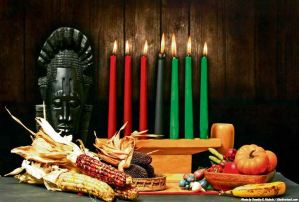
BY LAURA ONYENEHO, DefenderNetwork.com
Starting December 26, the seven-night celebration of Kwanzaa begins.
This African-American and Pan-African holiday is celebrated by millions worldwide with the goal to strengthen the values of African heritage and reinforce community among African-Americans.
If you are unfamiliar with this holiday tradition, here is what you need to know about Kwanzaa:
Who created Kwanzaa?
Dr. Maulana Karenga, professor and chairman of Black Studies at California State University created Kwanzaa in 1966. The word Kwanzaa derives from the Swahili phrase “matunda ya kwanza” or “first fruits” referring to the agricultural festival found throughout Africa. It became popular in the 1980s and 1990s in tandem with the black power movement., Dr. Karenga searched for ways to unify African Americans. He founded a cultural organization called US and began researching African harvest celebrations. He combined the influences of several different celebrations such as those of the Ashanti tribe in Ghana and Zulu of South Africa.
What are the seven symbols of Kwanzaa?
There are seven symbols of Kwanzaa.
- Kinara (candleholder): The kinara symbolizes the ancestors. The originators.
- Mishuma Saba (Seven Candles) Three red, Three green, One Black. The Black candle means Umoji and is lit on December 26. The three green candles represent Nia, Ujoma, and Imani which are placed to the right of the Umoja candle, while the three red candles representing Kujichagulia, Ujamaa, and Kuumba are on the left. These three colors come from the fla created by Marcus Garvey.
- Mkeka (The Mat) Symbolizes the historical and tradition foundation of the ancestors
- Mazao (Crops): Represents the gathering of the families reaffirming their responsibility to each other.
- Muhindi (ears of corn): Represents fertility and reproduction of children. Raising up the children to be upstanding members of their communities.
- Kikombe Cha Umoja (Unity Cup): Is a special cup used to perform the libation ritual. In many African countries, libations are poured in the memory of loved ones who have passed away.
- Zawadi (Gifts) Represents the fruits of the labor of the parents and the rewards sown by the children
Every evening there is a candle lighting ceremony that provides the opportunity for families to discuss the meaning and principles of Kwanzaa. One the first night, the black candle in the center is lit (representing the principle of Umoja/Unity). Every night for seven days a candle is lit and a principle is discussed.
What are the seven principles?
The seven principles of Kwanzaa are called Nguzo Saba, according to the Kwanzaa website.
Day one: Unity: (Umoja): Sustaining unity within the family, community, nation, and race.
Day two: Self-Determination (Kujichagulia): Defining, naming, and speaking for oneself.
Day three: Collective work and responsibility (Ujima): uplifting your community. Solving problems as a collective.
Day four: Cooperative economics (Ujamaa) Uplifting the community economically. Buying Black
Day five: Purpose (Nia) Building and developing the community to restore people to their greatness.
Day six: Creativity (Kuumba) It encourages people to utilize their talents the inspire the world and the next generations
Day seven: Faith (Imani): Black people, educators, and leaders believe in the victory of their struggle.
Help us Continue to tell OUR Story and join the AFRO family as a member – subscribers are now members! Join here!
The post What you need to know about Kwanzaa appeared first on AFRO American Newspapers .











